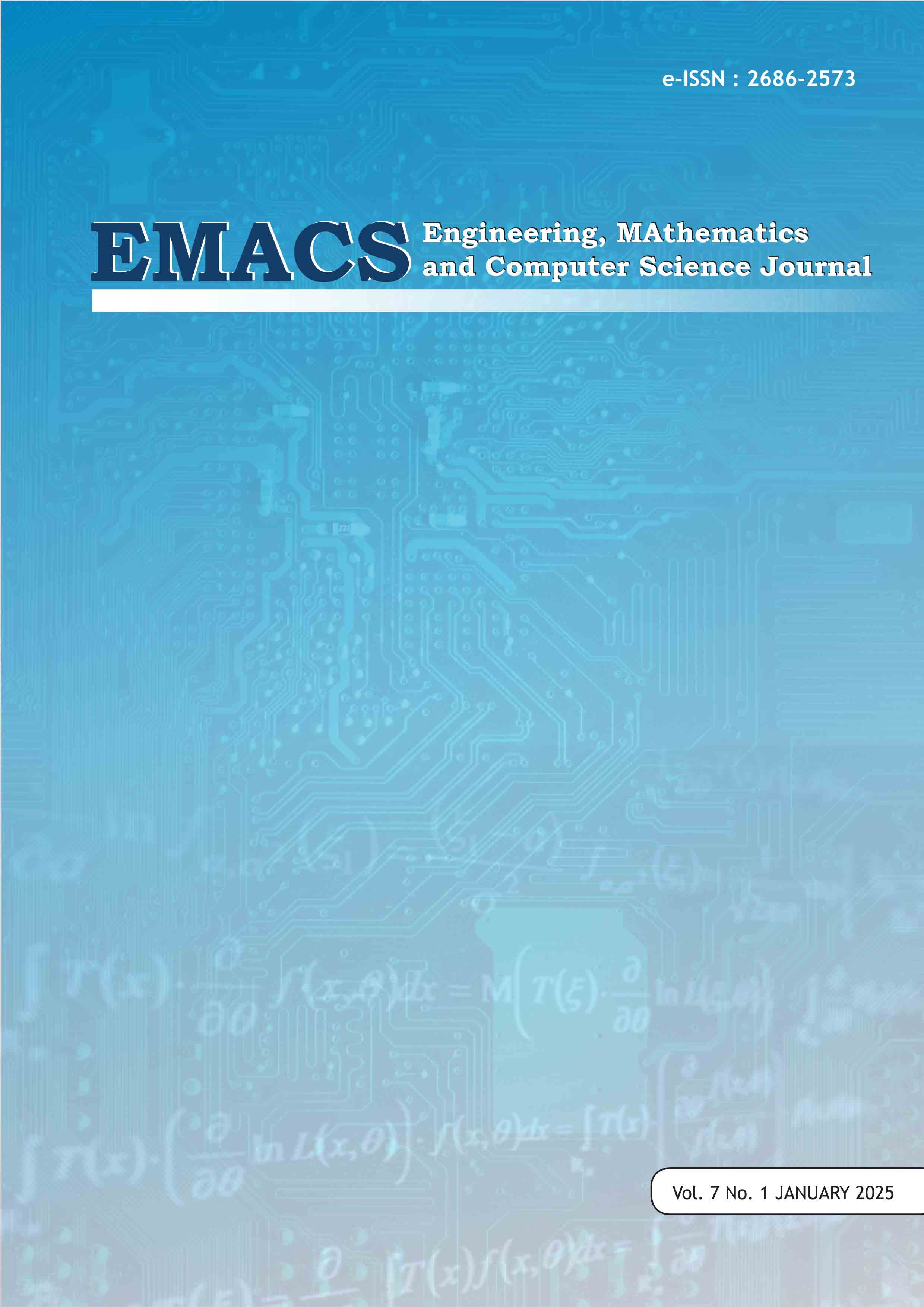Optimizer Comparison In Convolutional Neural Network For Real Time Face Recognition
DOI:
https://doi.org/10.21512/emacsjournal.v7i1.12058Keywords:
Face Recognition, Convolutional Neural Network, Adam, SGD, RMSPropAbstract
Face recognition is one of the computer vision technologies that's used in many industries. Face recognition always used in various sector that require the verification of an individual identity. There are many ways that can be used to develop face recognition, one of them is convolutional neural network. Convolutional neural network (CNN) is a deep learning neural network that is created specifically to process and analyze visual data, such as images and videos. CNN have the ability to learn many features from visual data, making them highly effective for tasks like face recognition. There are many factors that can affect CNN performance including the optimizers that are used in the neural network. Optimizers are the algorithm that adjust weights of the neural network to minimize error between the predicted output and actual target. This study used 10 different subjects for face recognition. In this study, the CNN model uses a training algorithm called backpropagation then will compare 3 different types of optimizers. The optimizers that used in this study are Adaptive Momentum (Adam), Root Mean Square Propagation (RMSProp), and Stochastic Gradient Descent (SGD). The results of the comparison will be shown in the form of performance metrics. The performance metrics include correct classification rate (CCR) as well as the confusion matrix of each model. CNN model with SGD optimizers has the highest CCR of 97.07%.
References
Alzubaidi, L., Zhang, J., Humaidi, A. J., Dujaili, A. Al, Duan, Y., Shamma, O. Al, SantamarÃa, J., Fadhel, M. A., Amidie, M. Al, & Farhan, L. (2021). Review of deep learning : concepts , CNN architectures , challenges , applications , future directions. In Journal of Big Data. Springer International Publishing. https://doi.org/10.1186/s40537-021-00444-8
Anu, T. A., Rosnelly, R., Irawan, D., Bulolo, P., & Hasibuan, U. (2023). Utilization of Digital Image and Convolution Neural Network Algorithm in Customer Satisfaction Survey with Facial Expressions. Journal of Computer Science, Information Technology and Telecommunication Engineering, 4(2), 420–427. https://doi.org/10.30596/jcositte.v4i2.15915
Backar, S. P., Purnawansyah, P., Darwis, H., & Astuti, W. (2023). Hybrid Fourier Descriptor Naïve Bayes dan CNN pada Klasifikasi Daun Herbal. Jurnal Informatika: Jurnal Pengembangan IT, 8(2), 126–133. https://doi.org/10.30591/jpit.v8i2.5186
Bhatt, H., Shah, V., Shah, K., Shah, R., & Shah, M. (2023). State-of-the-art machine learning techniques for melanoma skin cancer detection and classification: a comprehensive review. Intelligent Medicine, 3(3), 180–190. https://doi.org/10.1016/j.imed.2022.08.004
Cheng, W. C., Hsiao, H. C., & Lee, D. W. (2021). Face recognition system with feature normalization. International Journal of Applied Science and Engineering, 18(1), 1–9. https://doi.org/10.6703/IJASE.202103_18(1).004
Dacipta, P. N., & Putra, R. E. (2022). Sistem Klasifikasi Limbah Menggunakan Metode Convolutional Neural Network (CNN) Pada Webservice Berbasis Framework Flask. Journal of Informatics and Computer Science (JINACS), 3(04), 394–402. https://doi.org/10.26740/jinacs.v3n04.p394-402
Hanafie, A., Husain, N. P., Kumkelo, H., & Putri, R. R. (2023). Aplikasi Ekstraksi Wajah Menggunakan Algoritma Viola Jones. ILTEK : Jurnal Teknologi, 18(02), 87–91. https://doi.org/10.47398/iltek.v18i02.130
Hasyani, R. A., Simbolon, S. M., Mufida, Y., Ester, Y., & Ritonga, B. (2023). Klasifikasi Malaria melalui Penggunaan Convolutional Neural Network pada Citra Sel Darah. Student Research Journal, 1(6). https://doi.org/10.55606/srjyappi.v1i6.853
Ilahiyah S, & Nilogiri A. (2018). Implementasi Deep Learning Pada Identifikasi Jenis Tumbuhan Berdasarkan Citra Daun Menggunakan Convolutional Neural Network _ Ilahiyah _ JUSTINDO (Jurnal Sistem dan Teknologi Informasi Indonesia). JUSTINDO(Jurnal Sistem & Teknologi Informasi Indonesia), 3(2), 49–56.
Iskandar Zulkarnain Maulana Putra, T., Farhan Bukhori, A., Ilmu Pengetahuan Alam, dan, & Gadjah Mada, U. (2022). Model Klasifikasi Berbasis Multiclass Classification dengan Kombinasi Indobert Embedding dan Long Short-Term Memory untuk Tweet Berbahasa Indonesia (Classification Model Based on Multiclass Classification with a Combination of Indobert Embedding and Long . Jurnal Ilmu Siber Dan Teknologi Digital (JISTED), 1(1), 1–28. https://doi.org/10.35912/jisted.v1i1.1509
Kurniawan, R., Wintoro, P. B., Mulyani, Y., & Komarudin, M. (2023). Implementasi Arsitektur Xception Pada Model Machine Learning Klasifikasi Sampah Anorganik. Jurnal Informatika Dan Teknik Elektro Terapan, 11(2), 233–236. https://doi.org/10.23960/jitet.v11i2.3034
Purwono, Ma’arif, A., Rahmaniar, W., Fathurrahman, H. I. K., Frisky, A. Z. K., & Haq, Q. M. U. (2022). Understanding of Convolutional Neural Network (CNN): A Review. International Journal of Robotics and Control Systems, 2(4), 739–748. https://doi.org/10.31763/ijrcs.v2i4.888
Solihat, S., Widodo, S., & Sari, D. P. (2024). Analisis Perbandingan Optimizer pada Pelatihan Model Convolutional Neural Network untuk Kasus Klasifikasi Hewan Primata. Jurnal Media Informatika Budidarma, 8(1), 459–467. https://doi.org/10.30865/mib.v8i1.7274
Taqiyuddin, M., Adi, K., Dwi Nurhayati, O., & Ochi, H. (2023). Comparison of Optimizers for Drone Signal Detection Using Convolutional Neural Networks (CNN). E3S Web of Conferences, 448. https://doi.org/10.1051/e3sconf/202344802025
Yulina, S. (2021). Penerapan Haar Cascade Classifier dalam Mendeteksi Wajah dan Transformasi Citra Grayscale Menggunakan OpenCV. Jurnal Komputer Terapan, 7(1), 100–109. https://doi.org/10.35143/jkt.v7i1.3411
Downloads
Published
How to Cite
Issue
Section
License
Copyright (c) 2025 Elbert Elbert, Meirista Wulandari, Joni Fat

This work is licensed under a Creative Commons Attribution-ShareAlike 4.0 International License.
Authors who publish with this journal agree to the following terms:
- Authors retain copyright and grant the journal right of first publication with the work simultaneously licensed under a Creative Commons Attribution License - Share Alike that allows others to share the work with an acknowledgment of the work's authorship and initial publication in this journal.
- Authors are able to enter into separate, additional contractual arrangements for the non-exclusive distribution of the journal's published version of the work (e.g., post it to an institutional repository or publish it in a book), with an acknowledgment of its initial publication in this journal.
- Authors are permitted and encouraged to post their work online (e.g., in institutional repositories or on their website) prior to and during the submission process, as it can lead to productive exchanges, as well as earlier and greater citation of published work.
USER RIGHTS
All articles published Open Access will be immediately and permanently free for everyone to read and download. We are continuously working with our author communities to select the best choice of license options, currently being defined for this journal as follows: Creative Commons Attribution-Share Alike (CC BY-SA)





